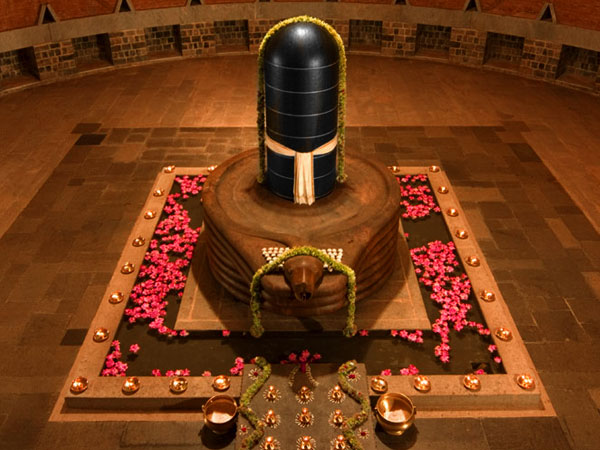The word "Lingam" means "mark" or "sign". The Shiva Lingam is a symbol for the worship of the Hindu god Shiva. Generally it signifies the magnificent light that is the indication or identity of Lord Shiva. This light or flame is solidified and makes the Shivlinga. The lower base of the structure is said to represent the lamp and the upper section, the flame.
In most Shiva temples, the bull Nandi is depicted facing the sanctum, symbolizing the human soul Jeevatma yearning for realizing its oneness with Paramatma, the ultimate reality.
As a total structure, the lingam is believed to contain the Holy trinity (trimurti - Brahma-Vishnu-Maheshwara) of Hinduism. The Hindu religion asserts that the god Brahma occupies the base layer of the lingam that touches the ground; the central position belongs to Lord Vishnu while the uppermost position is reserved for Lord Shiva.

A famous hymn in the Atharva-Veda Samhita sings a praise of the Yupa-Stambha, the sacrificial post, and describes its eternal nature. The worship of the Shiva-Linga is said to have originated from this hymn, which shows the Stambha to be put in place of the eternal Brahman.
The origin of the Shiva Lingam is a subject of great debate. According to some scholars, the use of this symbol for worship is an ancient Indian tradition extending back to the early Indus Valley civilization. The well-known historian Professor Arthur Llewellyn Basham said that the Shivalinga have been found in the Harappan remains and commented about the antiquity of the symbol:
"... Shiva was and still is chiefly worshipped in the form of the linga, usually a short cylindrical pillar with rounded top, which is the survival of a cult older than Indian civilization itself.... The cult of the linga, at all times followed by some of the non-Aryan peoples, was incorporated into Hinduism around the beginning of the Christian era, though at first it was not very important."
Many foreign scholars are of the view that the phallus symbolizes the linga, sexual organ, of Lord Shiva and the basin in connection with it represents the yoni, or vulva, of Goddess Durga. In a sense, the linga united with the yoni symbolizes creation. This view has however been rubbished by Swami Vivekananda who, in his lecture at the Paris Congress of the History of Religions in 1900, referred to the Atharva-Veda Samhita and asserted that the Shiva-Linga had its origin in the idea of the Yupa-Stambha or Skambha—the sacrificial post, idealized in Vedic ritual as the symbol of the Eternal Brahman.
Worship of a Shiv Linga is measured as the ultimate worship for Lord Shiva devotees. Worship of the Lord in any other form is considered secondary in importance to the veneration of lingam. Shiva Linga is considered to be the holy embodiment of Lord Shiva, which almost all pious Hindu devotees dedicatedly adorn and worship, especially during Maha Shivaratri.
Many references to the Shiv Linga can be found in the various Hindu religious texts. The renowned epic "Ramayana" shows how the demon king Ravana is gifted with tremendous powers following his unceasing worship of Shiv Linga. In the ‘Mahabharata’, one comes across the incident of Arjuna's invocation of the holy Shiv Linga and his attainment of the great weapon Pashupathastra.
But the most fascinating event associated with the greatness of Shiv Linga is the annual formation of an astounding lingam wholly out of ice at a cave of Amarnath. While atheistical eyes view this as a pure natural phenomenon, pious hearts believe this to be a divine act of Lord Shiva. Because of this, Amarnath (situated in the midst of beautiful Himalayas) is considered to be an extremely spiritual place. Every year, people from distant places come over to climb up the high mountains, only to have a glimpse of the startling ice Shiv Linga.

Apart from the Amarnath Shiv Linga, there also exists man-made Shiv Linga’s in the Hampi region of India. The total number of these lingams add up to a staggering figure of 1008. These emphasize the point that religion is the cornerstone of the Hindu faith and show the love and devotion of the believers for Lord Shiva, which draw them to the god, despite the strenuous journey and the chilly weather.